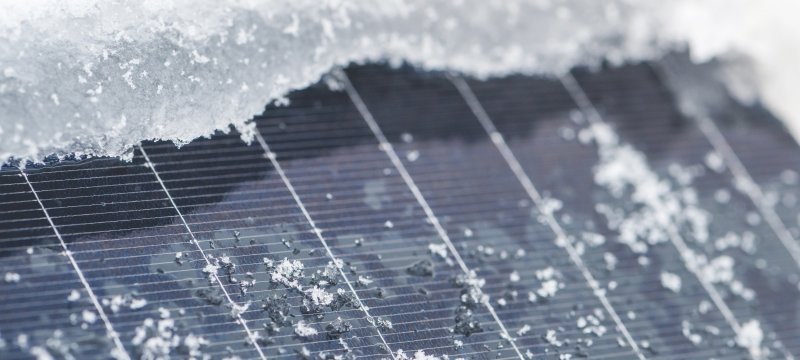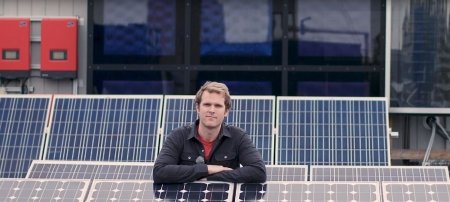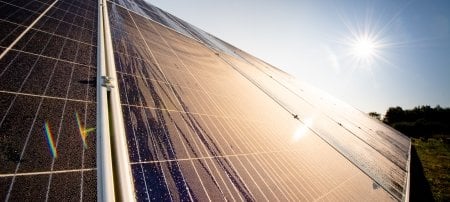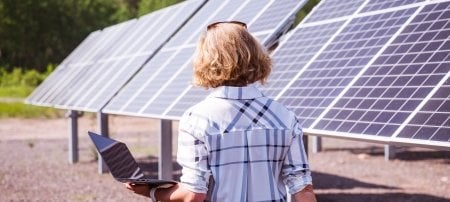Energy challenges are worldwide, but every solution is local. That's why researchers at Tech are pioneering strategies tailored for cold-climate communities in the Great Lakes region.
Location, location, location is more than a real estate adage. It's the wellspring for energy solutions, says Ana Dyreson, who leads Michigan Tech's Great Lakes Energy Group and collaborates on several climate- and energy-focused projects underway at Tech.
"I study the regional impacts and drivers of energy transition because new technologies and technological systems will function best when designed for the people and places where they will operate," she says.
When it comes to devising real solutions for real people, Dyreson, who grew up on the family farm in Portage, Wisconsin, also draws on life experience. "I know what it's like to lose power when we still have several hours of milking to do in the evening. We'd use flashlights and either milk by hand, or if possible, run PTO (power take-off) from a tractor," says the assistant professor of mechanical engineering-engineering mechanics. "We relied on home heating oil to keep the house warm."
As any Yooper who's suffered sticker shock from electric and home heating bills can attest, the energy required to sustain northern rural communities doesn't come cheap or easy. Improvements in cost, availability, and dependable climate-friendly alternatives won't come without continuous innovation, practical application and community buy-in.
It's a daunting process, complicated by issues including aging and unweatherized housing stock, a relatively sparse population, long heating seasons, and deep snow. That's why Dyreson and a host of collaborators with a variety of perspectives and backgrounds are going full-tilt on projects to reliably keep the lights and heat on for generations to come, even in the throes of a howling nor'easter.
"Energy has always fascinated me. It drives the world around us," says Dyreson. "The choices we make about how we as a society harness different energy sources, manage environmental impacts of production and distribution, and share social benefits and harms have widespread impact. As an engineer, this means I'll never lack interesting or meaningful work!"
An Array of Energy Possibilities
Ten miles north of Michigan Tech's main campus, Dyreson regularly walks the wide gravel rows of a farm of a different sort, one flanked by hundreds of solar panels at the US Department of Energy's (DOE's) northernmost Regional Test Center (RTC) for Emerging Solar Technologies.
Located at Tech's Advanced Power Systems Research Center near Houghton County Memorial Airport, the arrays at the RTC are mounted in a variety of configurations based on research projects being conducted by center partners. Some contain fixed panels, while other panels move on single-axis trackers, pivoting to follow the sun from east to west. Dyreson's group is focused on the trackers. They're studying photovoltaic (PV) performance in cold climates, with an emphasis on understanding and reducing snow cover.
"Being from the region certainly makes the work feel personal."
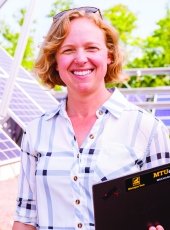
The reason the Department of Energy located a center here is abundantly clear. At the height of cold season, which stretches from October to late May on the Keweenaw Peninsula, researchers need snowshoes to reach the arrays.
"The snow was attractive to the DOE," says Dyreson. "PV systems are being deployed more often in northern climates. Lessons we learn here with extreme snow will be helpful to other locations, even those with moderate snowfall."
The effects of snow cover—or other shading on panels—is self-evident: less light, less electrons, less current, less power. But there are myriad nuances to consider, including the amount and texture of snow. Fluffy snow behaves differently than crusty or slushy snow. Dyreson's project addresses issues of optimal control for single-axis tracking systems and the impacts of widespread PV on the grid.

Do solar panels work in snowy climates? Tag along as Great Lakes Now visits the Regional Test Center for Emerging Solar Technologies to learn more about the Dyreson research team's findings.
"One might think with eight hours of snow predicted it might be wise to turn panels to a higher angle. The best control decision depends on multiple factors, including wind and temperature. How the trackers are designed and the material of the panels are also factors," Dyreson explains.
Beyond her work in snow shading on solar photovoltaics is a varied and expansive body of research centered at the crossroads of climate and energy change. Her expertise includes lake-effect climate, electrification of heating services, and the energy-generation potential of wind and waves on the lakes themselves. The work of other current members of the Great Lakes Energy Group reflects a breadth of initiatives centered on the energy needs of northern communities.
More Pioneers of the New Energy Frontier
Learning how PV systems can be designed to minimize snow retention time is the part of the solar energy research puzzle that occupies Great Lakes Energy Group member Ayush Chutani. The PhD student installed snow sensors that are being used for new smart controls, allowing the tracking system to be adjusted before, during, and after snowfall events.
"Ayush was the first student to join my group. He's an engineer who is highly motivated to address the climate crisis and has attended the UN COP (United Nations conference on climate change) multiple times," says Dyreson.
"I'm lucky to work with a talented and diverse group of students," she adds. "Each brings a slightly different focus to the issue of regional climate and climate change in the power sector."
Group member Jonathan Aurand, working from Minnesota, centers his research on natural gas combined-cycle power plants, where efficiency is boosted by capturing and routing waste heat. "He's making generalized models to study their operation in a changing climate," Dyreson says. "This work ties well to his background as a consulting engineer in the power sector."
Shelbie Wickett, working from Washington, is also drawing on her power-sector experience. "Shelbie's research aims to understand how widespread snow events may impact PV capacity, especially in the future, when we expect that power systems will rely more and more on solar power," Dyreson says, giving both Aurand and Wickett props for "managing serious work-life balance." They're also full-time instructors at other engineering schools.
On-site in the Great Lakes Energy Group lab, PhD student Adnan Hilal is learning about the evolution of electric power supply and demand. "His main project is on electrification in the rural north. He focuses on modeling home energy consumption, especially to understand how heat pump adoption could proceed in the rural north, where homes are often not well-weatherized," says Dyreson.
The Electrification in the Rural North project, funded by the Alfred P. Sloan Foundation, centers on heating and cooling demands for homes in rural Michigan, Minnesota, and Wisconsin.
"One question we are studying is what is the readiness of homes in the rural north for heat pumps. How many homes would benefit from weatherization before considering heat pumps?" says Dyreson.
On the project, engineers and social scientists team up to incorporate residents' perceptions and determine how both social and technical factors come into play. "We're working through a community advisory board to build relationships and ultimately survey individuals to gather their preferences and perceptions around renewable energy development on rural lands and heat pump adoption," Dyreson says.
Great Lakes Energy Group member Jacob Chizek, a master's student who also holds down a part-time engineering job, is researching air quality and home energy consumption in Baraga County. "This work considers the potential for heat pump adoption, but also considers the air quality and energy impacts of the waste-to-power plant in Baraga County," says Dyreson.
The newest group member is PhD student Keith Holliday, working out of Colorado. "He's a full-time software engineer in his day job and now seeks to add tools to his toolbox by becoming a mechanical engineer," Dyreson says. "Keith is studying how electric power system models incorporate the effects of climate change."
Beyond warm homes and hot showers is another area of work approached from a regional context: the electrification of transportation systems. Dyreson worked on a project that assessed the potential to electrify ferries and assess hydrokinetic energy in the Straits of Mackinac and is now partnering with Native Sun Community Power Development to address equity in the transportation energy transition.
"Thinking about the rural north and Indigenous communities, how can electric vehicle infrastructure reach and benefit communities rather than just following the highest-traffic routes?" she asks. The goal is to design EV infrastructure around the needs and preferences in different Indigenous communities in the rural north.
Dyreson is also part of Tech's new climate resilience center, known as C-CHARM—the Center for Climate-driven Hazard Adaptation, Resilience, and Mitigation—where she leads the energy infrastructure portion of the project.
"By addressing the unique climate and geohazards in this region, we hope to position communities—including the one we live in!—to better plan for the impacts of future climate in this region," says Dyreson. "C-CHARM is a good example of how work we are already doing in this space can be expanded."
As is the case with all of the energy transition projects Dyreson is involved in, collaboration and guidance from the community remains essential. Without input, the output can't succeed. Reaching consensus, especially when considering utility-scale projects, is as much about listening as engineering.
"I feel a strong connection to the land where I grew up, and I can sympathize with folks who are hesitant to see large-scale energy developments in their backyards," says Dyreson. "While ultimately I would personally prefer to have clean air and reduced carbon dioxide emissions from new, clean-energy development, it's important to hear all the voices of those who have connections to the land and weigh multiple factors."
Michigan Technological University is an R1 public research university founded in 1885 in Houghton, and is home to nearly 7,500 students from more than 60 countries around the world. Consistently ranked among the best universities in the country for return on investment, Michigan's flagship technological university offers more than 185 undergraduate and graduate degree programs in science and technology, engineering, computing, forestry, business, health professions, humanities, mathematics, social sciences, and the arts. The rural campus is situated just miles from Lake Superior in Michigan's Upper Peninsula, offering year-round opportunities for outdoor adventure.
